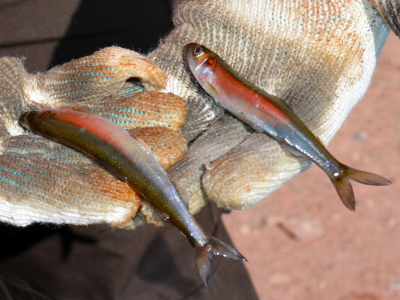The rainbow smelt is a small, slender schooling fish found in cold lakes and Atlantic coastal areas of North America.
Rainbow smelt are slender with iridescent silver flanks and a strongly forked tail. Adults are typically 6 to 9 inches in length. Females are usually larger than males.
Identifying features include their large mouth and eyes, canine teeth on tongue, protruding jaw, and adipose fin. Fresh rainbow smelt are said to smell similar to cucumbers.
Other common names include Atlantic rainbow smelt, smelt, American smelt, freshwater smelt, Atlantic smelt, leefish, and frostfish.
Although they are an introduced species, rainbow smelt have become an important forage species in the Great Lakes. Rainbow smelt preyed upon by walleye, trout, salmon, and other top level predators.
Landlocked smelt include both normal and dwarf specimens. Some lakes are known to contain populations of both variants.
Coastal rainbow smelt occur from Long Island Sound to the Canadian Maritimes.
How To Catch Rainbow Smelt
Rainbow smelt are popular species with anglers for eating as well as for bait. Smelt are caught by ice fishing, jigging, seining, dip netting, and other techniques.
Rainbow smelt are a schooling species. In late winter they congregate near streams or shorelines with spawning habitat. Pre-spawn fishing requires locating schools of fish.
In areas where ice fishing is possible, fishing huts are often set up over schools of smelt. Anglers fish with multiple outfits, rigged with small hooks and baited with insect larvae, worms, small minnows, or other baits.
Rainbow smelt are also caught with small jigs, metal spoons, and other lures that mimic baitfish. Jigging with lures is sometimes necessary when fish are suspended in the water column.
In early spring as water temperatures increase, rainbow smelt begin moving into streams or other spawning areas. During spawning runs, rainbow smelt are sometimes netted in large quantities.
Related Information
